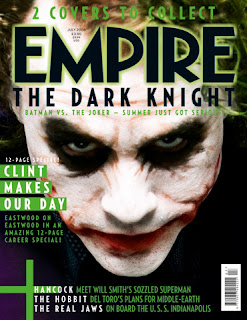I found that two major film magazines were 'Total FILM' and 'EMPIRE'. First I looked at 'Total FILM', the first thing that stood out to me was the big bold masthead which I thought was very appealling and easily caught my eye.
The clevel use of space means they were able to call the magazine 'Total FILM', I liked the effect of fitting the first part into the 'F' of Film. Also the big bold white text makes it stand out against any background used and means it can be a reccurring theme throughout all covers, this therefore provides a instant recognition and symbol to the audience as to which film magazine it is.
My favourite cover of 'Total FILM' is this one:
What I like most about this cover is the striking image which immediately catches the eye and a medium close up provides us with an insight into the actor character and costume. The dark background makes the character look very vibrant, colourful and makes the image the focal point of the magazine. The large anchorage text 'Massive 2010 Preview' informs the reader on first glance as to what this issue features, the colour of the text also ties in with the masthead therefore providing a nice colourscheme. The plain white and yellow text makes it readable and stand out without being over the top and taking the focus away from the main image.
Another film magazine is 'EMPIRE':
'EMPIRE' has given me the most inspiration. I love the big bold red text and the layering used to hide parts of the text however even though parts are hidden the magazine is still instantly recognisable because of the recurring theme of the red masthead used throughout the covers. As you can see with the 'Joker' cover, featuring the new Batman: The Dark Knight preview, when the masthead is a different colour layering isn't used and instead becomes the focal point along with the striking image.
'EMPIRE' use a range of different camera shots within their covers, from close ups to medium close ups and all are used effectively to achieve the best look.
My favourite within the covers I have found and which have given me the most amount of inspiration in producing my own are:
AND
I believe that I have had more inspiration into producing my own since researching into current magazines on the market. I feel that by taking the ideas from different magazines and putting them together into one piece can make my magazine into being the most effective and eye catching to the audience.
Before I begin to produce my magazine I will draw up drafts of different covers and take many different pictures as my starting point. From my work last year on my foundation portfolio, I believe I can carry my knowledge through into producing a high quality magazine cover. I will also make a questionnaire to hand out to my potential audience and ask for feedback.















